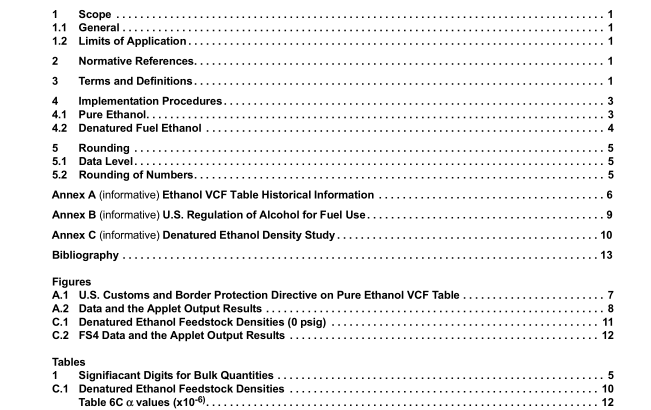API MPMS 11.3.3:2011 pdf free download.Manual of Petroleum Measurement Standards Chapter 11.3.3 Miscellaneous Hydrocarbon Product Properties— Ethanol Density and Volume Correction Factors
This standard covers density and volume correction factors for pure and denatured fuel ethanol. The actual standardconsists of the explicit implementation procedures set forth in this document.Sample tables and other examplescreated from a computerized version of this implementation procedure are presented as examples only and do notrepresent the standard.
1.2 Limits of Application
This standard is applicable at any liquid operating temperature to bulk (e.g. tank trucks, tank cargos, barges) pure(99+ %) ethanol and denatured ethanol containing ASTM D48061 allowed denaturants (natural gasoline, gasolineblend stocks, and unleaded gasoline) in the 2 % to 5 % by volume range.
2Normative References
The following referenced documents are indispensable for the application of this document. For dated references,only the edition cited applies. For undated references, the latest edition of the referenced document (including anyamendments) applies.
APIMPMS Ch.11.1-2004,Temperature and Pressure Volume Correction Factors for Generalized Crude olls,Refined Products,and Lubricating Oils (includes Addendum dated September 2007).
API MPMS Ch.12.1.1-2007,Calculation of Static Petroleum Quantities—Upright Cylindrical Tanks and MarineVessels.
3 Terms and Definitions
For the purposes of this document, the following definitions apply.
3.1
absolute densityp
The mass of a substance occupying unit volume at a specified temperature at atmospheric pressure or equilibriumvapor pressure.
NOTE Density as so defined is sometimes referred to as “true densify” or as “density in vacuo”or often just plain “density”When reporting density,the units of mass and volume used and the temperature of the determination have to be stated (e.g.kilograms per cubic meter or grams per millimeter at i “F or (t C).For the oil industy, if the temperature is unstated, standardtemperature(6o For 15C) should be assumed.
3.2
denaturants
Materials added to ethanol to make it unsuitable for beverage use under a formula approved by a regulatory agencyto prevent the imposition of beverage alcohol tax.
3.3
denatured fuel ethanol
Fuel ethanol made unfit for beverage use by the addition of denaturants under formula(s) approved by the applicableregulatory agency to prevent the imposition of beverage alcohol tax.
3.4
ethanol
Ethyl alcohol, the chemical C 2 H 5 OH.
3.5
fuel ethanol
A grade of undenatured ethanol with other components common to its production (including water) that do not affect the use of the product as a component for automotive spark ignition engine fuels.
3.6
gasoline
A volatile mixture of liquid hydrocarbons, generally containing small amounts of additives, suitable for use as a fuel in spark-ignition internal combustion engines.
3.7
gross observed volume
GOV
The total volume of all liquid and sediment and water, excluding free water, at observed temperature and pressure.
3.8
gross standard volume
GSV
The total volume of liquid and sediment and water, excluding free water, corrected by the appropriate volume
correction factor (VCF) for the observed temperature to a standard reference temperature (generally 60 °F or 15 °C).
NOTE If there is no sediment and water, GSV is the same as net standard volume (NSV).
3.9
natural gasoline
A natural gas liquid with a vapor pressure intermediate between condensate and liquefied petroleum gas.
NOTE This liquid hydrocarbon mixture is recovered at normal pressure and temperature and is much more volatile and unstable than commercial gasoline.
3.10
net standard volume
NSV
The total volume of liquid, excluding sediment and water and free water, corrected by the appropriate VCF for the observed temperature to a standard reference temperature (generally 60 °F or 15 °C).
NOTE If there is no sediment and water, GSV is the same as NSV.
3.11
pure ethanol
For the purposes of this standard, ethanol that is ≥ 99.0 % pure shall be considered pure.
3.12
volume correction factor
VCF
A factor that corrects the volume of a liquid at observed temperature and base pressure to its volume at standard reference temperature (generally 60 °F or 15 °C at 0 psig). A VCF is the dimensionless ratio of a product’s density at a given temperature divided by its density at standard reference temperature (D t /D 60 ) or its net standard volume divided by its gross observed volume (NSV/GOV). Also referred to as CTL (Correction for Temperature of a Liquid) in dynamic measurement.API MPMS 11.3.3 pdf download.API MPMS 11.3.3:2011 pdf free download
